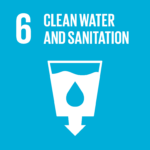Throughout. history, water has always had an impact on where we live.
Today, as climate change accelerates the global water crisis, the relentless increase in the movement of people around the world requires a considered response to turn crisis into opportunity.
RELEVANT SUSTAINABLE GOALS




There are over 1 billion migrants in the globe today, and water scarcity is responsible for 10% of the increase in worldwide migration. According to the World Bank’s newly issued flagship publication on water, a shortage of water, rather than an abundance, has a higher influence on migration.
Ebb and Flow: Water, Migration, and Growth is a new report that investigates the relationship between water and migration, as well as the consequences for economic development. This research investigates the relationship between water and migration, as well as the consequences for economic growth. The research is based on an examination of the world’s biggest data collection on internal migration, which includes over half a billion people from 189 population censuses in 64 countries from 1960 to 2015. It examines the relationship between rainfall shocks and migration in relation to other important characteristics such as age, gender, education, and household size. The report is divided into two sections. Water, migration, and development are all covered in Volume 1. Volume 2 concentrates on the Middle East and North Africa’s water, forced relocation, and violence.

Volume 1 – Ebb and Flow: Water, Migration, and Development
Water scarcity is responsible for 10% of the increase in worldwide migration. Moreover, climate change is hastening the global water crisis: 17 nations, home to 25% of the world’s population, are already experiencing extremely high levels of water stress.
- Water scarcity has a more significant influence on migration than water availability. Rainfall shocks, defined as rainfall that is considerably above or below a region’s long-term average, are projected to be the driving factor in water-induced migration in the coming years. Dry rainfall shocks have a five-fold more significant impact on out-migration than moist rainfall shocks.
- Rainfall unpredictability affects the poor world disproportionately, with more than 85 percent of those impacted residing in low- or middle-income nations. In addition, droughts are expected to intensify in the following years, according to scientists.
- The term “water migrant” is a vast generalization that is not supported by evidence. Indeed, the poorest generally lack the resources to relocate, even if doing so would enhance their livelihoods and prospects. Furthermore, migration in reaction to water constraints differs dramatically by national income, with people of poorer countries four times less likely to relocate than residents of affluent countries. These stranded communities may face a triple whammy of water scarcity, dwindling economic possibilities, and a lack of resources to relocate to better-off areas.
- Water shocks impact not only the number of individuals who relocate but also the skills that they carry with them. For example, labor migrants who leave locations with lower rainfall and frequent dry shocks typically have lower educational and skill levels and experience a pay difference of up to 3.4 percent at their destination, with significant policy consequences for receiving cities.
Global warming will increase the frequency of “day zero” incidents in the world’s cities, which presently house 55 percent of the human population. Rising heat stress and water shortages are threatening urban water supplies. In addition, changes in the global hydrologic cycle and water deficiencies in rural regions, which force agricultural laborers to metropolitan areas, are threats to city sustainability. With severe recent water shortages in Cape Town, Chennai, and So Paolo, scores of smaller towns are facing similar fates.
- Investing in water pays off. Water shocks are expensive; a drought may limit a city’s economic growth by up to 12%. Although adjusting to these occurrences can be costly, investing in policies and infrastructure that improve urban water resilience is critical because cities generate economic growth. Recycling wastewater and capturing stormwater are environmentally friendly alternative water supplies. Concepts such as “sponge city” that increase flood protection and absorb run-off provide more water sources for city people.
- Water policy must be innovative for cities to be smart. This entails creating incentives for practical water usage and correcting inequitable and wasteful subsidies. Globally, 6 percent of water and sanitation subsidies go to the lowest 20%, while 56% go to the wealthiest 20%. Subsidies like this perpetuate inequality and reward inefficiency. Moreover, they promote abuse of water by making it so cheap, endangering the sustainability of water services.
Global Governments need to protect people, livelihoods, and resources. A complementary range of policies can improve livelihoods and turn water-induced crises into opportunities.
- Make investments that are people-centered. Cash and in-kind transfers, for example, can help to safeguard populations experiencing severe water shocks. In addition, investing in water supply and sanitation, education, health care, and certain housing benefits both impoverished migrants and city inhabitants. Active labor market policies that foster skill development are also required, as are worker education and training expenditures.
- Ensure the survival of livelihoods in the place of origin. If carefully considered to minimize unexpected consequences, water storage and supplementary irrigation can successfully protect vulnerable rural populations from water unpredictability and shortage. Climate-smart agriculture and farmer-led irrigation can serve comparable functions while reducing environmental impact. Green infrastructure, such as watersheds and their accompanying trees that store, filter, and transport both surface and groundwater, may also improve the resilience and quality of water sources. Investing in their maintenance or restoration can give long-term advantages while also increasing employment generation in the immediate term.
- Maintain and protect urban water resources and infrastructure. As the world’s cities face rising demand from urban populations – including migrants from rural regions – and water supply shocks, improved demand-side management and resilience will be required. Cities’ impermeable concrete foundations obstruct drainage patterns, causing water to flow over the urban grid, causing flooding, and ultimately away from the city. Cities should be rebuilt to look like sponges that absorb water and store it below. Flexible ways to emergency reallocations must also be taken into account.

Volume 2 – Water In The Shadow Of Conflict (Middle East and North Africa)
In the Middle East and North Africa, water is more often a victim and casualty of violence than a significant generator of conflict (MENA). Although there have been minor incidents of violence and displacement resulting from water concerns, there is no evidence that water hazards create large-scale forced relocation or directly contribute to war.
- The MENA region has the world’s highest levels of forced displacement, with an estimated 7.2 million refugees, of whom 2.7 million are hosted in the region, and 12.4 million internally displaced people fleeing protracted armed conflicts. It is also the world’s most water-scarce region, with over 60% of the population living in areas with high water stress, compared with 35% globally.
- War and unemployment are more powerful drivers of migration within the MENA region than water-related phenomena such as drought. However, as the consequences of climate change grow, these historical patterns may no longer hold: climate change may worsen vulnerabilities and conflicts over water resources in places with poor governance, leading to a vicious cycle of water insecurity and fragility.
- Even though violence is an unforeseeable outcome of water hazards, conflicts commonly result in the targeting and destroying of water infrastructure. For example, water infrastructure has been targeted at least 180 times in Gaza, Yemen, Syria, and Libya since 2011, denying hundreds of thousands of people access to water.
- One of the most significant risks of persons displaced by violence is a lack of access to water. Access to safe drinking water is a daily challenge for millions of forcibly displaced Iraqis, Libyans, Palestinians, Syrians, Yemenis, and foreign migrants in the area. These difficulties are especially acute for the most vulnerable, such as people with disabilities and women, for whom water insecurity has ramifications for mental health, vulnerability to violence, and marginalization.
Contrary to common belief, water risks have traditionally resulted in more collaboration than conflict. This is true at the internal and international levels within MENA, involving transboundary rivers and aquifers. Moreover, long-term exposure to water shortage, like in other regions of the globe, promotes water users’ propensity for collaboration.
- Between 1948 and 2008, 56% of 975 water events involving transnational river basins in the Middle East and North Africa (MENA) were cooperative, 37% were conflictive, and 8% were neutral. Given the frequency of violent wars in the region throughout that period, it is noteworthy that water difficulties have typically led to collaboration.
- The apparent inclination for collaboration should not lead to complacency. Approximately 37% of the occurrences are contentious. According to data, the most significant levels of transboundary water cooperation, such as treaties and agreements over shared water resources, are more challenging to accomplish than technical and commercial accords. Water-related formal declarations of war have not been recorded in the historical database; nonetheless, notable acts of violence have been documented, particularly regarding the Israeli-Palestinian conflict. These include, for example, damage to water supply infrastructure in the May 2021 Gaza conflict (see World Bank Gaza Rapid Damage and Needs Assessment) and other instances reported in academic literature.
- Domestic water tensions can be exacerbated by pre-existing socioeconomic grievances combined with a drought or a water scarcity, especially in the absence of robust institutions. The 2018 water crisis in Basra serves as a sharp reminder of the tensions that might build due to water scarcity and decreasing service quality amid a protracted armed war.
The MENA region urgently needs to move towards water resilience. The protracted displacement crisis and water scarcity calls for a shift from a narrow focus on humanitarian support to policies that promote long-term water security and resilience to future shocks. Given the prolonged nature of conflicts in the region, waiting for their resolution is not a feasible strategy. Development agencies need to join forces with humanitarian actors and ensure that interventions (such as drilling wells) do not undermine long-term sustainability.
- An integrated framework to respond to water risks in MENA includes a series of building blocks. At the most basic level, in crisis situations, the minimum response includes partnerships with humanitarian and security actors, emergency assistance, and support for continuity of water utilities. Moving into the prevention and development stage includes two additional building blocks:
- People and area-based interventions to address community grievances in access to water resources, promote labor-intensive watershed restoration, monitor and strengthen infrastructure safety, and help water service providers to win back market share.
- National interventions to enhance disaster management systems, identify decentralized and low-tech infrastructure solutions, promote cost recovery and efficiency of water utilities, and focus on regulation and monitoring of groundwater abstraction.
- When working towards this cooperation, policy-makers will likely face trade-offs between short-term, uncoordinated measures to respond to immediate water needs and long-term measures needed to address structural water issues. Failure to recognize and manage these trade-offs can significantly undermine water security prospects for the forcibly displaced and their host communities.
- Policies to reconstruct national water institutions and infrastructure are likely to fail without the foundations of a renewed social fabric and trust in institutions, which can be achieved through people- and area-based interventions.
This broad policy focus goes well beyond forced displacement and acute crises, and involves seeing water with a new lens across MENA. This is crucial for growth and development in a region that faces the greatest expected economic losses from climate-related water scarcity, estimated at 6–14 percent of GDP by 2050 (see High and Dry: Climate Change, Water, and the Economy, World Bank, 2016).
The article was initially published on 30th January 2022.


